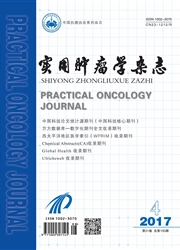

 中文摘要:
中文摘要:
目的分析化疗所致胃肠道反应对乳腺癌患者抑郁,焦虑状态的影响。方法对74例化疗后恶心及56例化疗后无恶心的乳腺癌患者采用自编一般情况问卷、Zung抑郁自评量表(sDs)和Zung焦虑自评量表(SAS)评定其抑郁、焦虑状态。恶心组患者症状得到有效控制并结束一周期化疗后,再次对其进行量表调查。结果恶心组及无恶心组存在抑郁症状人数分别为38人和14人,焦虑症状人数分别为29人和11人,两者比较差异具有统计学意义(P〈0.05);恶心组及无恶心组抑郁评分各为54.64±11.49及42.00±8.92,焦虑评分各为51.29±10.17及41.45±7.94,两者比较差异具有统计学意义(P〈0.05)。患者恶心得到有效控制后,抑郁评分为46.56±9.45,焦虑评分为44.05±8.36,与未控制前比较均明显降低,差异具有统计学意义(P〈0.05),但仍高于无恶心组(P〈0.05)。结论化疗所致胃肠道反应与乳腺癌患者抑郁、焦虑状态的发生和持续有关。
 英文摘要:
英文摘要:
Objective To investigate the effect of chemotherapy - induced gastrointestinal reactions on the mood status of patients with breast cancer undergoing chemotherapy. Methods 74 breast cancer patients with chemotherapy - induced nausea and 56 breast cancer patients without chemotherapy - induced nausea were as- sessed with Self - Designed Questionnaire, Self - Rating Depression Scale (SDS) and Self - Rating Anxiety Scale (SAS). After the nausea control,the SDS and SAS were assessed again. Results The number of depression in breast cancer patients with chemotherapy - induced nausea and without chemotherapy - induced nausea were 38 and 14,respectively(P 〈 0.05 ). The number of anxiety in breast cancer patients with chemotherapyinduced nausea and without chemotherapy - induced nausea were 29 and 11, respectively ( P 〈 0.05 ). The scores of SDS in nausea and non - nausea groups were 54.64 ± 11.49 and 42.008.92, respectively. The scores of SAS in nausea and non - nausea groups were 51.29± 10.17 and 4l. 45 ± 7.94, respectively ( P 〈 0.05 ). The scores of SDS and SAS in nausea group were lower after nausea released ,but it was still higher than non -nausea group( P 〈 0.05 ). Conclusion Chemotherapy - induced gastrointestinal reactions have effect on the mood status of patients with breast cancer.
 同期刊论文项目
同期刊论文项目
 同项目期刊论文
同项目期刊论文
 期刊信息
期刊信息
